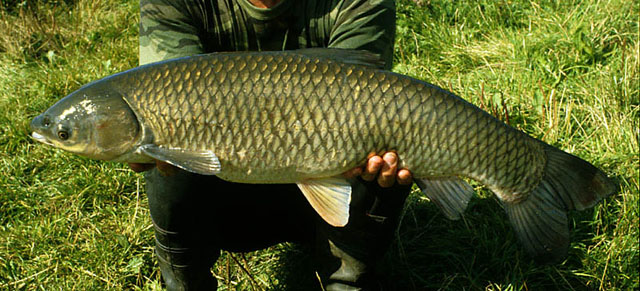| Cyprinidae (Minnows or carps), subfamily: Squaliobarbinae |
| 150 cm TL (male/unsexed); max.weight: 45 kg; max. reported age: 21 years |
|
demersal; depth range 0 - 30 m, potamodromous |
| Asia: China to eastern Siberia (Amur River system, Ref. 1441). Widely transported around the world (Ref. 7248). Persists only in Europe by stocking (Ref. 59043). Introductions often brought with it the parasitic tapeworm Bothriocephalus opsarichthydis (synonym of B. acheilognathi) (Ref. 12217). Several countries report adverse ecological impact after introduction. |
|
Dorsal spines (total): 3-3; Dorsal soft rays (total): 7-8; Anal spines: 3-3; Anal soft rays: 7-11. No barbels. Snout very short, its length less than or equal to eye diameter. Postorbital length more than half head length (Ref. 4967). 18 soft rays for caudal fin (Ref. 40476). Diagnosed from rather similar species Mylopharyngodon piceus by having the following characters: body olive to brassy green above, silvery white to yellow below; body cylindrical; pharyngeal teeth laterally compressed, serrated, with a groove along grinding surface, usually in two rows, 2,5-4,2 (Ref. 59043). |
| Adults occur in lakes, ponds, pools and backwaters of large rivers (Ref. 5723), preferring large, slow-flowing or standing water bodies with vegetation. Tolerant of a wide range of temperatures from 0° to 38°C, and salinities to as much as 10 ppt and oxygen levels down to 0.5 ppm. Feed on higher aquatic plants and submerged grasses; takes also detritus, insects and other invertebrates. One of the world's most important aquaculture species and also used for weed control in rivers, fish ponds and reservoirs (Ref. 9987). Spawn on riverbeds with very strong current (Ref. 30578). Utilized also fresh and eaten steamed, pan-fried, broiled and baked (Ref. 9987). Considered as a pest in most countries because of the damages made to submerged vegetation (Ref. 43281). |
|
Not Evaluated
(Ref. 96402)
|
| potential pest |
|
Source and more info: www.fishbase.org. For personal, classroom, and other internal use only. Not for publication.
Page created by Jen, 05.08.02,
php script by kbanasihan 06/09/2010 ,
last modified by
dsantos, 20/08/10

